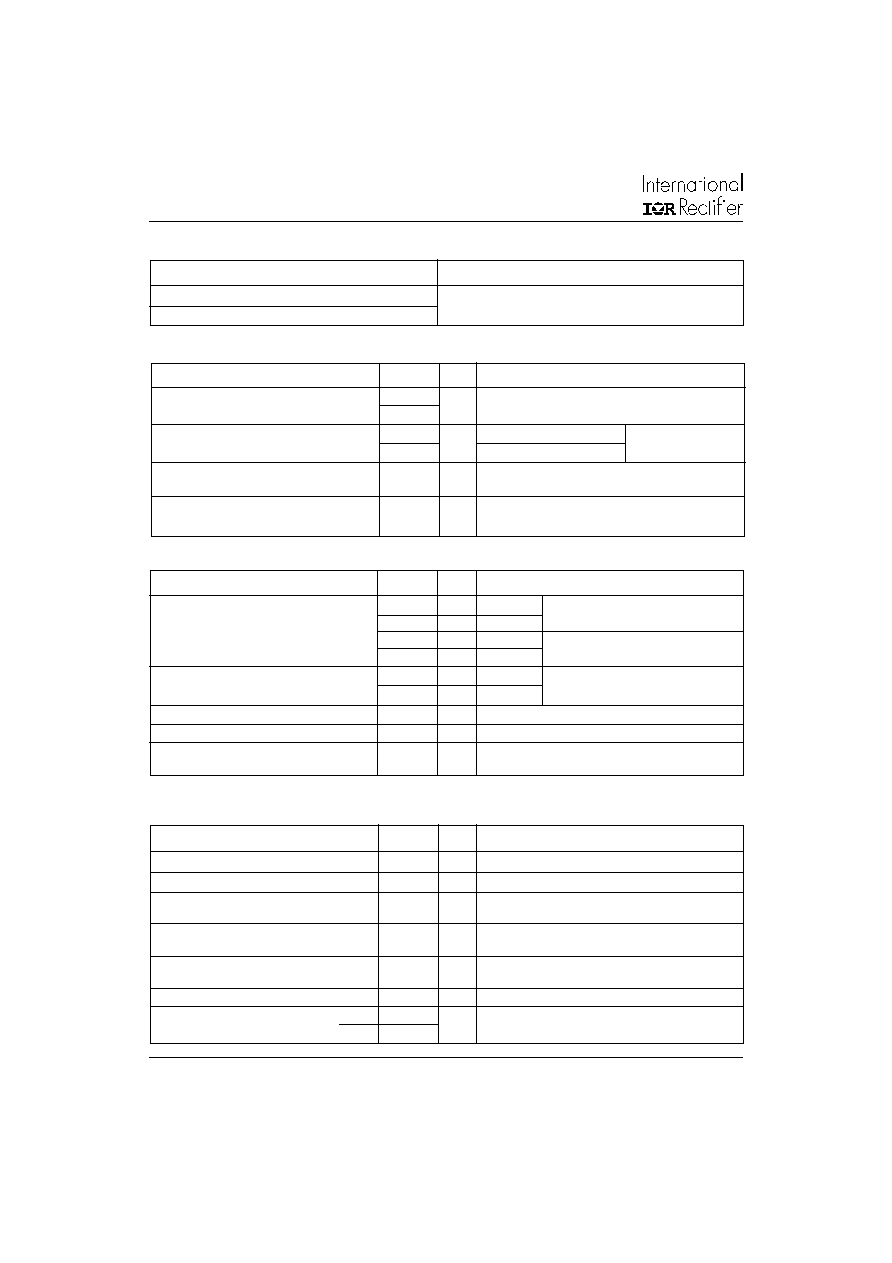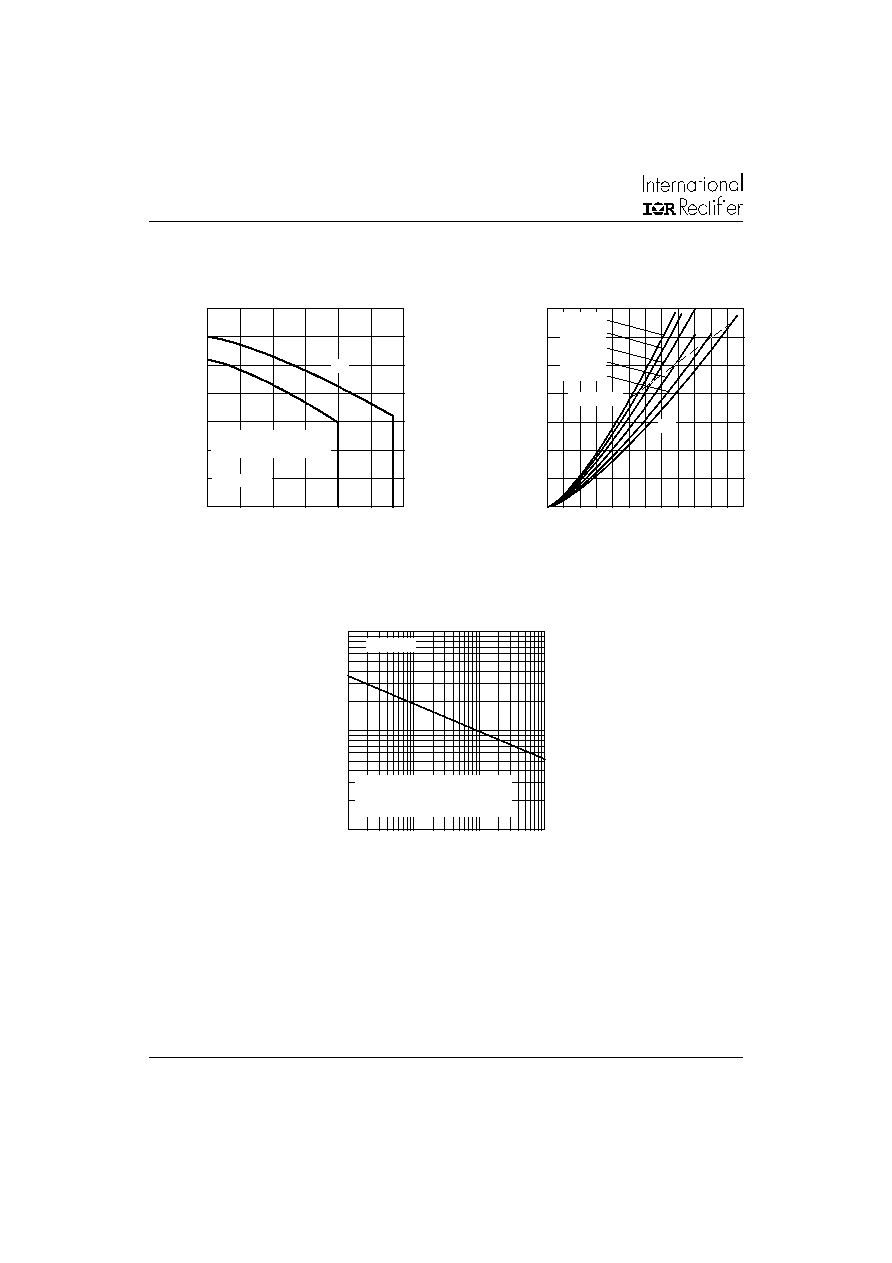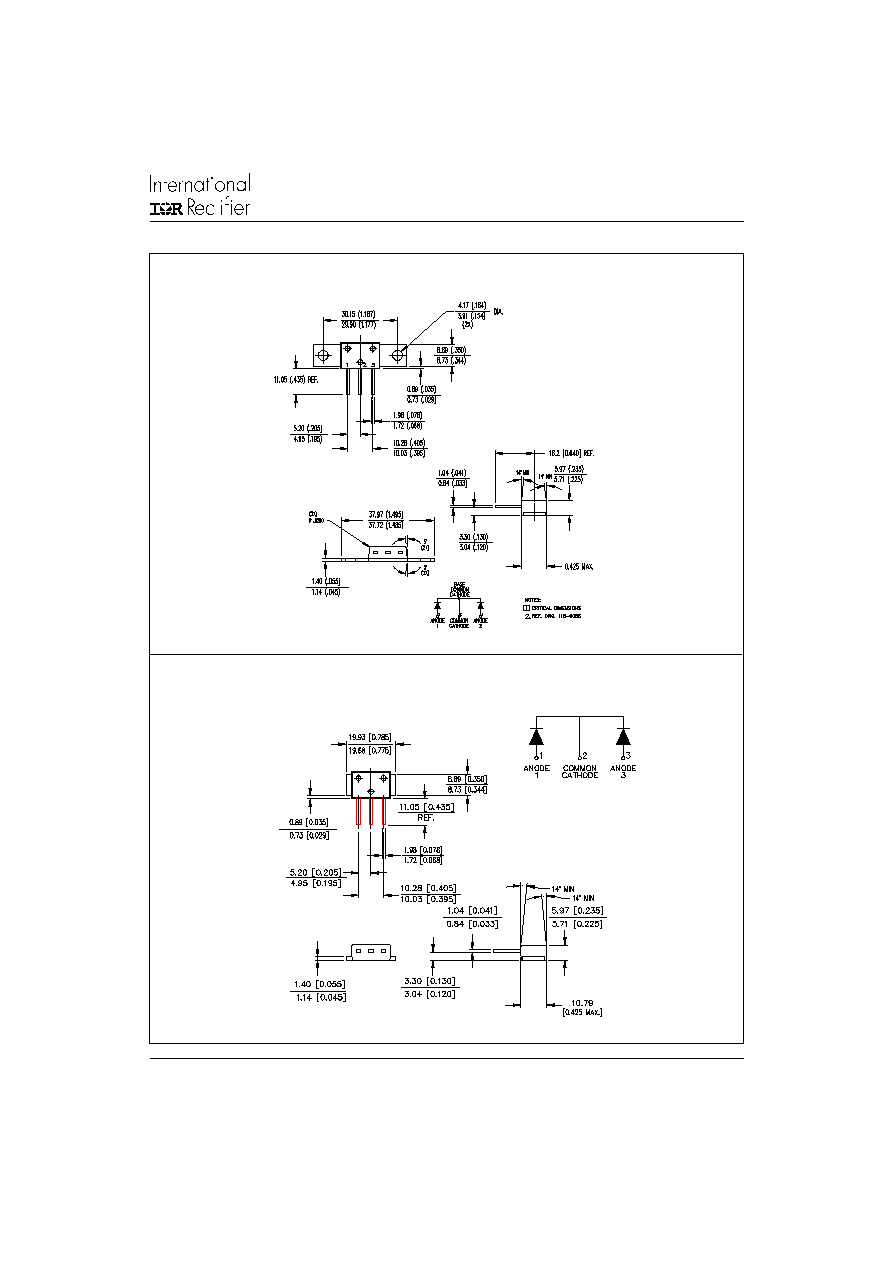Äîêóìåíòàöèÿ è îïèñàíèÿ www.docs.chipfind.ru

80 Amp
88CNQ060A Series
Bulletin PD-20058 rev. B 01/02
www.irf.com
1
Major Ratings and Characteristics
I
F(AV)
Rectangular
80
A
waveform
V
RRM
60
V
I
FSM
@ tp = 5 µs sine
5000
A
V
F
@
40 Apk, T
J
= 125 °C
0.56
V
(per leg)
T
J
range
- 55 to 150
°C
Characteristics
88CNQ...A Units
The 88CNQ060A center tap Schottky rectifier module has
been optimized for very low forward voltage drop, with
moderate leakage. The proprietary barrier technology allows
for reliable operation up to 150°C junction temperature. Typical
applications are in switching power supplies, converters, free
wheeling diodes, and reverse battery protection.
150 °C T
J
operation
Center tap module
High purity, high temperature epoxy encapsulation for
enhanced mechanical strength and moisture resistance
Low forward voltage drop
High frequency operation
Guard ring for enhanced ruggedness and long term
reliability
New fully transfer-mold low profile, small
footprint, high current package
Description/Features
SCHOTTKY RECTIFIER
New GenIII D-61 Package
Case Styles
D61-8
88CNQ...A
88CNQ...ASM
88CNQ...ASL
D61-8-SM
D61-8-SL

88CNQ060A Series
2
Bulletin PD-20058 rev. B 01/02
www.irf.com
Electrical Specifications
Part number
88CNQ060A
V
R
Max. DC Reverse Voltage (V)
V
RWM
Max. Working Peak Reverse Voltage (V)
Voltage Ratings
V
FM
Max. Forward Voltage Drop
0.58
V
@ 40A
(Per Leg)
(1)
0.77
V
@ 80A
0.56
V
@ 40A
0.67
V
@ 80A
I
RM
Typical Reverse Leakage Current
0.64
mA
T
J
= 25 °C
(Per Leg) See Fig. 2
(1)
240
mA
T
J
= 125 °C
C
T
Max. Junction Capacitance (Per Leg)
5200
pF
V
R
= 5V
DC
, (test signal range 100Khz to 1Mhz) 25°C
L
S
Typical Series Inductance (Per Leg)
5.5
nH
Measured lead to lead 5mm from package body
dv/dt Max. Voltage Rate of Change
10000
V/ µs
(Rated V
R
)
T
J
= 25 °C
T
J
= 125 °C
V
R
= rated V
R
Parameters
88CNQ Units
Conditions
T
J
Max. Junction Temperature Range
- 55 to 150
°C
T
stg
Max. Storage Temperature Range
- 55 to 150
°C
R
thJC
Max. Thermal Resistance Junction
0.85
°C/W DC operation
to Case (Per Leg)
R
thJC
Max. Thermal Resistance Junction
0.42
°C/W DC operation
to Case (Per Package)
R
thCS
Typical Thermal Resistance, Case
0.30
°C/W Mounting surface , smooth and greased
to Heatsink (D61-8 Only)
Device flatness < 5 mils
wt
Approximate Weight
7.8 (0.28)
g (oz.)
T
Mounting Torque
Min.
40 (35)
(D61-8 Only)
Max.
58 (50)
Thermal-Mechanical Specifications
Kg-cm
(Ibf-in)
Parameters
88CNQ Units
Conditions
(1) Pulse Width < 300µs, Duty Cycle <2%
60
I
F(AV)
Max. Av.Forward Current (Per Leg)
40
A
50% duty cycle @ T
C
= 120°C, rectangular wave form
See Fig. 5
(Per Device )
80
(Rated V
R
)
I
FSM
Max. Peak One Cycle Non-Repetitive
5000
5µs Sine or 3µs Rect. pulse
Surge Current (Per Leg) See Fig. 7
600
10ms Sine or 6ms Rect. pulse
E
AS
Non-Repetitive Avalanche Energy
75
mJ
T
J
= 25 °C, I
AS
= 1 Amps, L = 0.57 mH
(Per Leg)
I
AR
Repetitive Avalanche Current
1.0
A
Current decaying linearly to zero in 1 µsec
(Per Leg)
Frequency limited by T
J
max. V
A
= 1.5 x V
R
typical
Following any rated
load condition and with
rated Vr
applied
Absolute Maximum Ratings
A
Parameters
88CNQ Units
Conditions

88CNQ060A Series
3
Bulletin PD-20058 rev. B 01/02
www.irf.com
Fig. 2 - Typical Values Of Reverse Current
Vs. Reverse Voltage (Per Leg)
Fig. 3 - Typical Junction Capacitance
Vs. Reverse Voltage (Per Leg)
Fig. 4 - Max. Thermal Impedance Z
thJC
Characteristics (Per Leg)
Fig. 1 - Max. Forward Voltage Drop Characteristics
(Per Leg)
Instantaneous Forward Current - I
F
(A)
Forward Voltage Drop - V
FM
(V)
Reverse Current - I
R
(mA)
Reverse Voltage - V
R
(V)
Reverse Voltage - V
R
(V)
Junction Capacitance - C
T
(p F)
Thermal Impedance Z
thJC
(°C/W)
t
1
, Rectangular Pulse Duration (Seconds)
0.01
0.1
1
10
100
1000
0
10
20
30
40
50
60
125°C
100°C
75°C
50°C
25°C
Tj = 150°C
100
1000
10000
0
10
20
30
40
50
60
Tj = 25°C
1
10
100
1000
0
0.2
0.4
0.6
0.8
1
1.2
Tj = 150°C
Tj = 125°C
Tj = 25°C
0.001
0.01
0.1
1
0.00001
0.0001
0.001
0.01
0.1
1
10
Single Pulse
(Thermal Resistance)
D = 0.75
D = 0.50
D = 0.33
D = 0.25
D = 0.20
Notes:
1. Duty factor D = t1/ t2
2. Peak Tj = Pdm x ZthJC + Tc
2
t
1
t
P
DM

88CNQ060A Series
4
Bulletin PD-20058 rev. B 01/02
www.irf.com
Fig. 5 - Maximum Average Forward Current
Vs. Allowable Lead Temperature
Fig. 6 - Maximum Average Forward Dissipation
Vs. Average Forward Current
Fig. 7 - Maximum Peak Surge Forward Current Vs. Pulse Duration
Average Forward Current - I
F(AV)
(A)
Allowable Lead Temperature (°C)
Average Forward Current - I
F(AV)
(A)
Allowable Power Loss (Watts)
Square Wave Pulse Duration - t
p
(microsec)
Non-Repetitive Surge Current - I
FSM
(A)
0
5
10
15
20
25
30
35
0
10
20
30
40
50
60
DC
RMS Limit
D = 0.20
D = 0.25
D = 0.33
D = 0.50
D = 0.75
90
100
110
120
130
140
150
160
0
10
20
30
40
50
60
DC
see note (2)
Square wave (D = 0.5)
80% rated Vr applied
100
1000
10000
10
100
1000
10000
Tj = 25°C
At Any Rated Load Condition
And With Rated Vrrm Applied
Following Surge
(2) Formula used: T
C
= T
J
- (Pd + Pd
REV
) x R
thJC
;
Pd = Forward Power Loss = I
F(AV)
x V
FM
@ (I
F(AV)
/
D) (see Fig. 6);
Pd
REV
= Inverse Power Loss = V
R1
x I
R
(1 - D); I
R
@ V
R1
= 80% rated V
R

88CNQ060A Series
5
Bulletin PD-20058 rev. B 01/02
www.irf.com
Outline Table
Outline D61-8-SM
Dimensions are in millimeters and (inches)
Outline D61-8
Dimensions are in millimeters and (inches)




